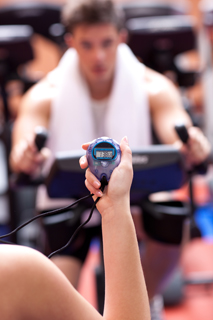Power Training and Indoor Cycling
 If you want to improve you speed throughout the year, whether for mountain biking, road cycling, or touring, power training is the way to go. The main purpose of power training is to improve your speed and ability to climb hills, but it is useful even if you only cycle on flat terrain where power is not an issue, as power training can help you to develop leg strength, tone muscles, and improve your overall fitness.
If you want to improve you speed throughout the year, whether for mountain biking, road cycling, or touring, power training is the way to go. The main purpose of power training is to improve your speed and ability to climb hills, but it is useful even if you only cycle on flat terrain where power is not an issue, as power training can help you to develop leg strength, tone muscles, and improve your overall fitness.
The term "power" refers not to the amount of work you are doing but rather the rate you perform the work. In other words, it is the amount of effort you exert of a given period of time. By utilizing a power meter for indoor cycling, especially at times when the weather is unsuitable for outdoor riding, you are able to build and maintain power throughout the year and constantly set yourself new goals.
Why Are Power Meters Preferred to Heart Rate Monitors?
Power meters are fast gaining popularity over the traditional heart rate monitors as they become more widely available for all types of cyclists. The reason is simple: power meters provide athletes with an instant and accurate measure of how hard the cyclist is working, whereas a heart rate monitor simply shows the response to physical activity, and there is often a time lag between exertion and heart response.
Heart rate can be affected by a variety of external factors including temperature, altitude, terrain, and wind resistance as well as the cyclist's hydration and nutrition. This can result in a significant difference between workouts that is not due to how hard the athlete is working. Power meters, however, always measure the impact of the activity itself.
What are the Benefits of Power Training with Indoor Cycling?
1. Power training is possibly the best way to improve your hill climbing ability as well as improving the speed of your climb. As factors such as VO2 max and threshold heart rate actually limit your power ability and cannot be easily measured, a power meter is your best tool to determine how much power you are generating. By noting power levels for the entire workout or just a short interval, you can predict how well you will be able to face steep climbs when you head back outdoors.
2. With power training, you can target specific types of riding such as climbing, sprinting, or time trials. By identifying your weaknesses, you can develop an objective and train to specifically improve this area. For hill climbing, you will need to determine the grade of the road, either from your altimeter or from an online resource, to determine the appropriate power needed. For sprints, note the watts generated during intervals, and for time trials past races, and set yourself a goal for improvement.
3. By comparing yourself to other riders, you can evaluate your relative strength in a particular field. For example, your ability to generate power either in short bursts or for long periods of time will determine for which types of riding events and races you are best suited. Once you have found what you are good at, you can better challenge yourself with what you find difficult.
Power training is not just about maintaining your fitness and strength during the offseason when it is not possible to cycle outdoors; it is also a powerful tool to improve speed and hill climbing ability. By utilizing a power meter, you will be able to get the most out of all your indoor cycling workouts.

